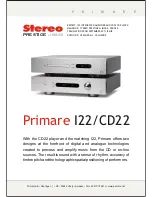
Primare AB • Renvägen 1 • SE - 35245 Växjö • Sweden • Tel +46 470 729215 • www.primare.net
P
R
I
M
A
R
E
This player/converter/amplifier system has proprietary technologies, which feature new power,
filtering, conversion and amplification (see our chapters on technology by image) circuits. The
result is a truly coherent sound aesthetic of great beauty without any auditory fatigue and with many
opportunities to adapt to personal tastes.
Listening Conditions
We first listened to the I22 and the CD22 separately, then together, to determine their best operating
conditions. First of all, and critically, the I22 requires a very long run-in period (as with all switch-
mode power supply and switching amplification) of about one week to deliver its full open, analytical
abilities and optimal dynamic capacity.
We stress this point because if you remove the I22 from the box and plug it in, you are unlikely to
hear the potential of this amplifier. After run-in, it requires at least half an hour to stabilize its
performance. After that, the choice of power leads is critical to get the best separation, precision of
timbre and the layering of sounds. We used power cords from MIT, O2A and Silent Wire to replace
the original. Interconnects with an upper-midrange emphasis must be avoided and the most neutral
chosen to expose excellent dynamic capability. Finally, as far as speakers are concerned, we found
that, without changing the sound character, the I22 is capable of driving the most complex loads
with a disconcerting ease. Furthermore the I22 is quite astounding in its ability to retain bass quality
and speed. The remarkable CD22 player was auditioned while making many comparisons between
the various sampling frequencies it offers. The conclusions will go against many preconceived
ideas. In general the 44.1 kHz frequency appears to offer the best spatial coherence, with robust,
well-structured timbres. The higher the oversampling frequency, the more micro-information is
defined, but at the cost of a little control over bass, dynamics, timbre accuracy and stereo width.
Thus, at 192 kHz, rich micro-detail gives an impression of greater transparency: a quite ethereal
character especially from large orchestral works, but with a slightly shortened stereo image width.
To paraphrase the title of a Pirandello play, one is tempted to say "to each his own truth", but be
aware, you must already have speakers with great definition to really appreciate these minute
differences. In the end, we opted to listen at 44.1 kHz where all the parameters appeared the most
balanced to us.
Listen
With the BWV70 Cantata by Bach, the Primare set reveals the entire character of the performance
under the direction of John Eliot Gardiner, while distinguishing, with an extremely precise analytical
capability, between the different instruments of the orchestra, in particular the trumpet and the
reverberant oboe, whose pitch is finely in tune, without nasal effect. The chorus, in two sections that
respond to each other, has a very warm tonal togetherness characterised by extremely rich textures
that do not dry out through the upper-midrange. Given the complexity of the message for
reproduction, the Primare CD22/I22 system gives a naturally faithful rendition without lapsing into
REVIEW: I22 INTEGRATED AMPLIFIER AND CD22 CD PLAYER




























